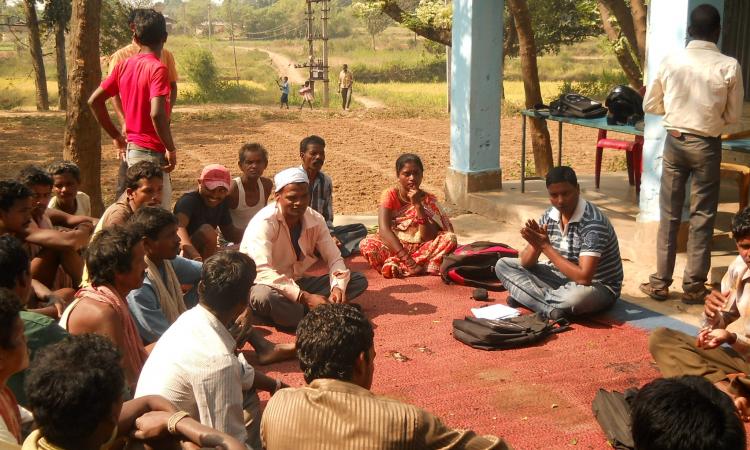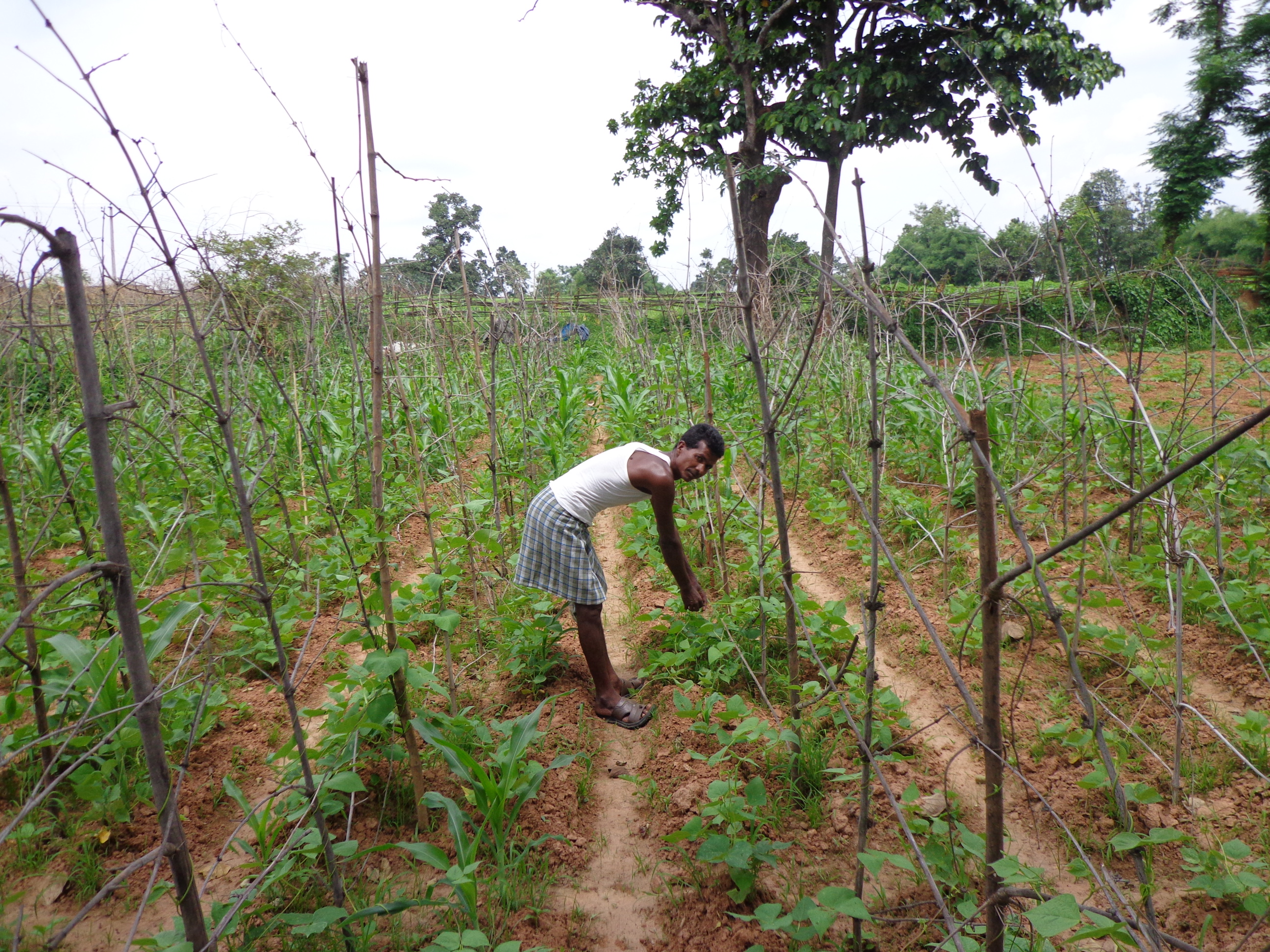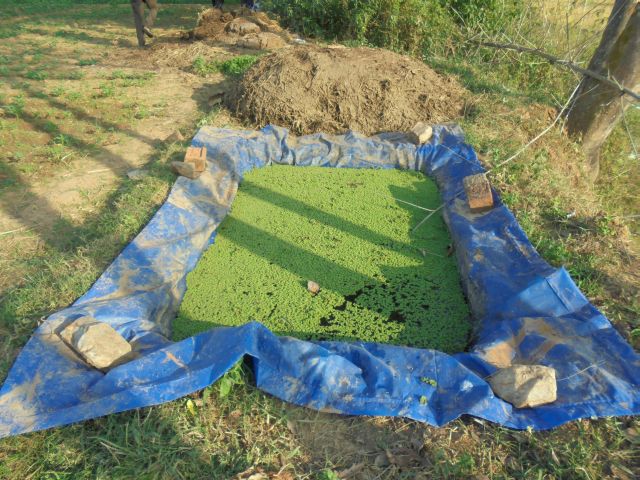
Chedua Bedia is a 47-year-old marginal farmer from Dubulabeda village, Angara block of Ranchi district. In addition to being a successful farmer, Chedua has founded a school and motivates other farmers from his village to attend classes! This is a special school called the Farmers Field School where groups of farmers learn how to integrate the various components of agriculture into their farms.
The Farmers Field School
The School, which was set up by Chedua along with some other farmers, was supported by SPWD, an NGO that promotes the concept of Sustainable Integrated Farming Systems (SIFS) for small and marginal farmers. The schools began with a focus on single crops such as paddy, groundnut etc., but as the group matured it moved on to integrating the various components of agriculture. The schools are run throughout the cropping season. The curriculum of the school was designed taking into consideration various aspects of farming and to equip farmers with the knowledge needed to develop their SIFS farms. Farmers receive training on how to manage crops, waste and pests. Meaningful discussions are held in the farms on crop growth, climate, soil conditions and constraints to crop production. Based on these observations, farmers make informed decisions to increase yields and improve the soil fertility of their fields.
These schools now serve as the training ground for new farmers. The schools are run by lead farmers under a facilitator and a master trainer. This form of class has helped the farmers gain confidence. They also discuss among themselves, raise questions, and attempt to find solutions by visiting the field. Leaders and farmer-trainers of the Schools are provided training at regular intervals.
Chedua's story
 Chedua is a model farmer today but, just three years ago he barely did any farm planning though he owned multiple assets in his 5.5 acre of farmland. Most of it lay barren and he could only cultivate one crop in his 2 acre lowland. He commited a few mistakes that resulted in crop losses but his farming practices were typical to what most practiced in his village. During monsoons, he cultivated a few traditional paddy varieties. This would give him a meager yield of around 3 quintals an acre. He used this for his household consumption and supplemented this with the grains he got from the public distribution system.
Chedua is a model farmer today but, just three years ago he barely did any farm planning though he owned multiple assets in his 5.5 acre of farmland. Most of it lay barren and he could only cultivate one crop in his 2 acre lowland. He commited a few mistakes that resulted in crop losses but his farming practices were typical to what most practiced in his village. During monsoons, he cultivated a few traditional paddy varieties. This would give him a meager yield of around 3 quintals an acre. He used this for his household consumption and supplemented this with the grains he got from the public distribution system.
The only nutrient available in his farm comprised of farmyard manure, which was inadequate due to the few animals he had. He depended on bulky chemical inputs which cost him Rs 3500 per acre. Farm income being too little, Chedua had to migrate to the nearby city of Ranchi for labour work between February and May. In drought years, his situation used to worsen because of the irregular monsoon. Chedua admits, “my produce was insufficient to meet the household food security requirements. As a result, we were buying cereals and built up a hefty loan”.
Sustainable Integrated Farming Systems (SIFS) virtually replicates nature
Chedua’s farming system was faced with problems because of what experts call the breaking up of the ecology-farming linkage. Until a few decades ago, the agriculture in the area depended on internal resources. Organic matter was recycled and environmental degradation had not set in. Agricultural yields though modest, were steady. Multiple crops were grown in the farms, and rotation of crops provided more nitrogen, which assured healthy soils. In addition, pest and disease outbreaks like the ones seen these days was not common.
Thanks to the School, Chedua and many others were saved. ‘SIFS imitates nature by not only utilizing crops for production, but also varied types of plants, animals, bird, fish, as well as other aquatic flora and fauna’ (1). According to Karunakar Aruk, a field activist involved in the work, "These resources are pooled and used in a manner that the waste of one is recycled as resource for the other. This energy efficient system enhances the overall yield, income and nutrition of the people".
 Chedua started integrated farming by dividing his farm for different purposes. He introduced high quality seed materials and made a shift from single to triple cropping system. He cultivated cash crops like pea, potato, and off season vegetables like tomato as summer crops. Mixed cropping of maize and dwarf beans was done in the monsoon season. He introduced organic manuring practices to enhance the soil nutrient status. Crops, cattle, ducks and hens formed a part of the self-sustaining cycle. Small ponds were dug to help harvest water received from the 1400 mm average annual monsoon.
Chedua started integrated farming by dividing his farm for different purposes. He introduced high quality seed materials and made a shift from single to triple cropping system. He cultivated cash crops like pea, potato, and off season vegetables like tomato as summer crops. Mixed cropping of maize and dwarf beans was done in the monsoon season. He introduced organic manuring practices to enhance the soil nutrient status. Crops, cattle, ducks and hens formed a part of the self-sustaining cycle. Small ponds were dug to help harvest water received from the 1400 mm average annual monsoon.
After adopting the SIFS approach, Chedua got 11-12 qtl/acre of paddy as against a yield of 3 qtl/acre earlier. Chedua earned a profit of Rs 25000 and Rs 12000 respectively in two seasons from his homestead land by cultivating vegetables using organic practices. He used this income to purchase an electric motor for irrigation purposes. His household is also able to consume pesticide-free, healthy produce these days. This was just the beginning. A little later, he was also able to change his straw roof to asbestos sheet roof by investing Rs 40000 from the enhanced incomes from shifting to SIFS approach.
Chedua says that the adoption of organic practices has improved the soil profile as well as its water holding capacity. Also, the crop biodiversity is being maintained. He is glad that he has a steady income from his farming system and does not need to go out for wage work. Not only is he cultivating his own land but also that of others on rent basis.
Farmers of nearby villages have replicated his farming practices. Chedua now plans to produce his own seed materials for paddy and vegetable, and is looking forward to some training on quality seed production. He also hopes to cultivate pure organic produce from his farmland on a large scale. Farmers in his village are confident that this approach will stand the test of time. The lush paddy fields of Chedua stand as a proof of their assertion.
"We finally have regular nutritious food at home", Chedua’s wife beams with assurance.
Endnotes and references
(1) A facilitator’s manual: Sustainable Integrated Farming systems, Welthungerhilfe 2014
(2) The article deals with a program implemented by Society for Promotion of Wastelands Development with support from Welt Hunger Hilfe. The program’s outreach is in twenty-five villages in Arsha block of Purulia and Angara block of Ranchi.
/articles/farmers-field-school-jharkhand-shows-way-integrated-farming